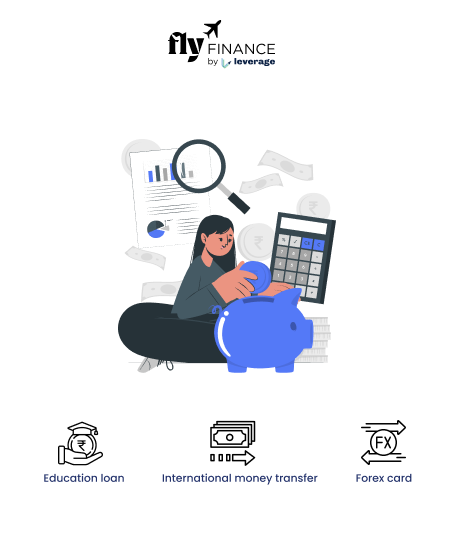One comes across many financial terms in the banking sector, especially when taking education loans to study abroad. Some of these terms include RLLR, MCLR, EMIs, and NPAs. While we have already covered the full form of EMI, the full form of RLLR and details about MCLR, we will talk about the full form of NPA, and important details related to NPA, in this blog.
Table of contents
NPA Full Form in Banking
NPA stands for Non-Performing Assets. RBI states- “An asset becomes a non-performing asset when it ceases to generate income for the bank”.
These refer to the loans and advances the banks and financial institutions lent and now the repayments are missed or delayed. In simple words, when a lender foregoes interest or principle payments for a specific period, generally 90 days, the debt is considered a non-performing asset. Breaking the full form of NPA can also make it easier for you to understand the term.
Consider it from the bank’s perspective- the bank lent you loans. The repayment of the loan is considered an asset for them as the loan amount (principle + interest) is yet to be received. However, if the borrower has stopped the repayment and it’s been more than 90 days- then these loans turn into non-performing assets for banks that have stopped/ missed/ delayed the repayment.
- NPAs usually occur when the loan agreement is broken and the borrower cannot meet the obligations to repay the loan.
- Economic recessions and slowdowns can lead to a situation where the borrowers may struggle to repay the loans due to reduced income or business losses.
- Poor credit management may also lead to a borrower’s inability to make interest and principal repayments.
Also Read: Learn all the important details of using SIPs to repay education loans efficiently and plan the repayment of the loan on time.
What Happens to NPAs When Borrowers Stop the Payments?
Borrowers are expected to manage their finances appropriately so that the loan lent to them is paid in a timely manner. In case, the borrower is unable to continue with the loan repayments for more than 90 days, the lender can enforce the selling of vouched assets.
The banks and other financial institutions get NPAs (Non-performing Assets) listed on their balance sheet, the lender influences the borrower to liquidate the assets that were pledged as a part of the debt agreement. In the case of collateral-free loans (i.e. absence of assets), the lender acknowledges the debt as bad debt and sells it at a cheaper rate to any collective agency.
Types of Non-performing Assets
90 days is usually the standard duration for the debt to be classified as non-performing assets. However, the exact duration is based on the terms and conditions of each loan. Depending on the duration of how long the asset has been an NPA, there are different types of Non-performing assets. Let’s have a look at these types-
Sub-Standard Asset
If an asset remains an NPA for a period of more than 90 days but less than 12 months, it is referred to as a sub-standard asset. These assets have a high chance of turning into bad loans as they exhibit a probability of remaining loan defaulters.
Doubtful Asset
An asset is considered a doubtful asset when the repayment of the amount is overdue for more than 12 months. These assets have a high risk of loss.
Loss Assets
Loss Assets are considered uncollectible. It means that the loss has been identified by the financial institution, but the amount is not yet written off wholly. Such assets have little value that is unrecoverable and are written off as bad debts.
Restructured Assets
These are the types of NPAs that have been modified and are a case of education loan restructure by the lender to provide temporary relief to borrowers facing financial challenges.
Also Read: Know all about the best forex cards for Indian students in the UK to overcome the hassles of money management while studying abroad.
Example of NPA
Let us consider an example of NPA- Raj Sharma took an education loan from the State Bank of India. Due to Raj’s financial situation, he stopped the payment of principal and interest amount. It’s been 4 months since the loan repayment was missed. This becomes a case of non-performing assets and the bank will list this as an NPA is their balance sheet.
FAQs on Full Form of NPAs
The full form of NPA is Non-Performing Assets. These are the missed/ delayed/stopped repayments of the loans advanced to the borrowers by the banks for a specific period, generally 90 days.
NPAs usually occur when the loan agreement is broken and the borrower cannot meet the obligations to repay the loan. Poor credit management may also lead to borrowers’ inability to make interest and principal repayments.
When the borrowers stop the repayment for an extended period, the lender forces the borrower to liquidate the assets that were pledged as a part of the debt agreement.
90 days is usually the standard duration for the debt to be classified as non-performing assets. However, the exact duration is based on the terms and conditions of each loan.
There are different types of NPAs depending on the duration of how long the asset has been an NPA. These types are- sub-standard assets, doubtful assets, loss assets, and restructured assets.
This was all about the full form of NPA, its types, and its impacts. International students studying abroad must be clear of this term to ensure timely payments of loans and not let it become an NPA for the banks.
To know more about education loans, the best bank accounts for students, forex and banking experience for global students or international money transfers, reach out to our experts at 1800572126 to help ease your study abroad experience.
Follow Us on Social Media





























